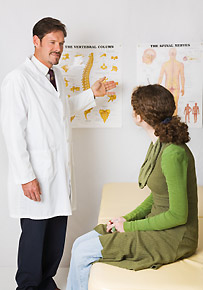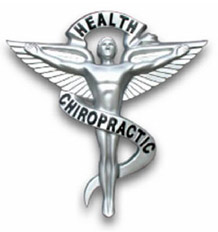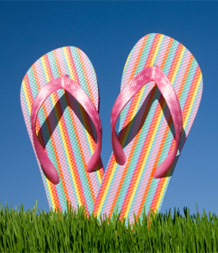 |
 |
|
 Taking your first few trips to the chiropractor can be intimidating.
It helps to have an idea of what to expect, before you step into the office. Your
first visit to the Chiropractor will be a health assessment or consultation.
Your practitioner will likely provide treatment once the assessment is complete. Taking your first few trips to the chiropractor can be intimidating.
It helps to have an idea of what to expect, before you step into the office. Your
first visit to the Chiropractor will be a health assessment or consultation.
Your practitioner will likely provide treatment once the assessment is complete.
During
the assessment, your Chiropractor will acquire basic health information from
you, such as blood pressure, height, weight, and any information about your
health history or medical conditions. During this time, he or she will
determine the nature, history, and scope of your complaints. This is a good
time to talk to your practitioner about when your discomfort started, or why
you decided to visit a Chiropractor.
The practitioner will also perform
a thorough examination, including a Range of Motion (ROM) assessment,
orthopedic assessment, neurological tests, soft tissue and spinal alignment.
These objective measures of your spine, joints, nerves and muscles will be used
to better assess your condition and help determine the cause of your symptoms. If
necessary, x-rays will be taken.
During your visit, your
chiropractor will discuss with you an action plan for treatment, and will
likely set goals and discuss the process for healing your ailments. Sticking to
this treatment plan is vital to a speedy recovery - missing too many treatments
can set further back.
Once you've been thoroughly evaluated,
you will receive chiropractic treatment, massage and other
appropriate therapy. It's important to remember that Chiropractic is not a
miracle cure, and you may continue to experience some discomfort after your
initial visit.
|
|
 |
 |
 Alternative medicine, as used
in the modern western world, is any treatment program that is not considered
conventional medicine. Some examples of this include Chiropractic, Massage
Therapy, Acupuncture, Homeopathy, and Ayurveda. Alternative medicine, as used
in the modern western world, is any treatment program that is not considered
conventional medicine. Some examples of this include Chiropractic, Massage
Therapy, Acupuncture, Homeopathy, and Ayurveda.
These types of treatments are
called complimentary when they are used in conjunction with a conventional approach.
Using Chiropractic care while taking pain medications prescribed by your doctor
means that you are using complimentary medicine. This is a very common tactic
with chiropractic, especially after an auto accident or other injury.
Chiropractic is a unique form
of complementary and alternative medicine - or CAM. It is the most
widely
accepted method of alternative treatment, and may surprise many
patients to
learn that it is still considered an alternative medicine. Chiropractic
is also
more regulated than most other forms of alternative treatments, and
each state
has a rigorous education and licensure process. Chiropractic medicine
is the
most widely prescribed and used CAM in the United States.
Chiropractic is even covered by an increasing number of health
insurance policies, including state medicaid programs.
The claims made by
alternative medicine practices are slow to be accepted by the medical community
because of the sensitivity to human health. As evidence-based assessment of
safety and efficacy becomes more available, many of these practices continue to
become more incorporated into the medical mainstream. There is a plethora of
information regarding alternative treatments. Look into all your options and
see what the facts have to say.
|
|
 |
 |
|
 A Favorite in the summertime,
these breezy shoes pose many risks to your short term and long term health when
worn more than occasionally, or for longer walks. Vegging out on the beach in
your favorite flip flops is one thing - going for trail walks is another. A Favorite in the summertime,
these breezy shoes pose many risks to your short term and long term health when
worn more than occasionally, or for longer walks. Vegging out on the beach in
your favorite flip flops is one thing - going for trail walks is another.
The reason? Flip Flops provide little or no support to the ankle
and only minimal shock absorption during weight-bearing activity. What this
means to your joints is increased wear and tear in the joint surfaces of the
ankle, knee, and spine. You also tend to
alter the way you walk, which triggers a domino effect of physiological issues,
starting with the feet, the ankles, and on up through the lower back and hips. Many
people report swelling or discomfort in the knees and ankles after long periods
of time in flip flops.
However, pinched nerves, maladjustment of the spine, and
tendinitis are just the beginning of the potential for problems. Injuries are
also increased with wearing these tread-less shoes. While flopping around on
our feet and offering no protection against slips, it's easy to slip, twist and
ankle, or worse, get your foot stuck under a gas or brake pedal and have a car
accident.
Your best bet? Save the flip flops for lazing around the pool,
beach or shower rooms, and wear fitted shoes and sandals for everything else.
Your shoes should support your arches, feel comfortable and fit the entire foot
without "flopping" off.
|
|
 |
 |
 Much attention is often paid to the healthful benefits of
nutrition and the heart and cardiovascular system, but seldom is advice seen
for how to eat for healthy joints. Here are a few nutritional elements that are
vital for keeping your joints and cartilage in tip-top shape. Much attention is often paid to the healthful benefits of
nutrition and the heart and cardiovascular system, but seldom is advice seen
for how to eat for healthy joints. Here are a few nutritional elements that are
vital for keeping your joints and cartilage in tip-top shape.
- Manganese
is a major player in building cartilage in the body by boosting the glucosamine
in the body - which maintains healthy cartilage, and thus, joints. Some great
sources for Manganese: Whole Grains, Beans, Seafood, Dark leafy Greens, Milk,
and Nuts.
- When
included in your diet, Omega 3s give your body anti-inflammatory support and
improve blood flow and mental health. Omega 3s provide the joints with the
support they need to stay functioning properly. Some natural sources include:
Flax seeds, Walnuts, Cod Liver Oil, Egg Yolk, and certain types of fish, such
as Salmon, Cod, Trout, and Sardines.
- Vitamins
C & E are an antioxidant rich duo and support each other's function. While
Vitamin C is the hero of healthy bones and joints with its ability to help the
body form collagen, it can't perform at peak without its partner, Vitamin E. Collagen is a protein that is found in your
bones, tendons and cartilage. Citrus fruits, strawberries, watermelon,
cantaloupe, tomatoes, broccoli, corn, nuts and oats are all great sources for
this powerful duo.
Surprising
as it may seem, it's easy to have a strong, healthy musculoskeletal system with
a few easy additions to your diet. Try the fish recipe in the side column to
get started.
|
|
 |
|
|
|
 |
|
In This Issue
|
|
 |
|
Contact Information
|
Your Name

800-123-4567
my website
|

|
|
Safety on the Job
|
Whether
you work in the construction industry, in a retail store, or behind a desk, the
workplace can be a dangerous place for you and your skeletal system.
Here are a
few things to keep in mind to stay healthy and safe:
- Lift
with your knees. Keep your back straight, squat, and lift
using the leg muscle to bear the weight as you come to standing position.
- Avoid
leaning back excessively as you are carrying loads. If it is cumbersome, get
help.
- Take a
break! Regardless of your job, sitting or standing for 8 hours can be brutal on
the back, hips and knees. Go for a walk, sit down if you stand all day, and stand up if you sit all day.
- Report
injuries and accidents immediately! Carpal Tunnel and similar long-term
ailments should be reported as close to onset as possible, and start
treatment right away to ensure workman's compensation coverage.
|

|
|
Stretch!
|
Feeling cooped up or achy? Time to Stretch!
Stretching increases the blood circulationto the achy muscles and provides relief.
By relaxing tight muscles, you help prevent
injuries and misalignments caused by muscle tension. Here are a few great
pointers to keep you limber:
- Take breaks frequently to stretch, especially if you are
doing repetitious things.
- Listen to your body. If it aches, stretch into the ache, and
back the other direction.
- Try over all stretching sessions three times per day to keep
your muscles fresh all day.
|

|
|
Recipe for Salmon with Citrus Honey
|
|
Honey
and citrus juices flavor these tasty salmon fillets, and the combination of healthy omega 3s from the
Salmon, and the glucosamine booster Vitamin C makes this dish a winner for your
joints and cartilage. Great with Rice.
Ingredients:
4
salmon fillets, about 6 ounces each, skin on
4
tablespoons honey
3 tablespoons
fresh lime juice
2
tablespoons orange juice
Sea
salt and freshly ground black pepper
Directions:
Preheat oven to 400° Grease a 9x13x2-inch baking pan. Place salmon, skin-side down, in the prepared
baking pan. Combine the honey, lime juice, and orange juice, stirring until
well blended. Sprinkle the fillets with salt and pepper then
spoon the honey and juice mixture over the fillets. Bake for 10 to 12 minutes or
until fish flakes easily with a fork. Sprinkle the fillets with salt and pepper then
spoon the honey and juice mixture over the fillets. Bake for 10 to 12 minutes or
until fish flakes easily with a fork.
|
|
 |
